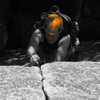I've been trying out this device for a bit now and thought I'd write a bit of a review in case there are other maritimers out there with an interest in being able to get out on those days you can't find a partner.
In the last year I've found moving to a new area and working shift work can make it a hassle to find partners willing or able to climb on a regular basis (maybe it's my breath, I dunno). Faced with this dilemma, and not willing to do too much soloing (at the risk of starting that thread up again, lol) I started looking for safe methods to get out on a rope on my own.
I experimented a lot with the Grigri. I found that it was allright at locking when I needed a break and was conscious of setting the device up to catch me to, but it wasnt necessarily garanteed that you were going to be caught up as you fell without warning. I also found that I usually had to manually feed the device rope every couple of feet, pretty much making anything above 5.9 impossible to climb with confidence. Even backed up to a rope cam it was a dicey proposition, and rope soloing on lead was out of the question.
During a trip to North Conway, I spotted a WI Soloist on for cheap and picked it up thinking I'd give it a whirl. After a half dozen outings I've managed to get it fairly dialed thanks to some generous Trial and Error.
About half the size and price of the Silent Partner that I just didnt' have the heart to buy, the Soloist is a very simple metal cage housing a cam in-line with your rope. You have to take the device apart to insert the rope, after which it attaches via a chest harness/biner. A second hole in the bottom allows for a loop of cordlette to connect to your harness.
In practice this takes some getting used-to. Adjusting the tension between the device and your waist harness is key, as too much sag affects the performance of the device. When properly fitted, I found that it was not super comfortable.
I tried top-roping first, ascending on a single line while clipping into bite's of rope every 10 feet or so. The soloist needs a little bit of weight to start things along. I found about a half dozen loops of rope tied up below the device allowed it to feed freely, and after 15 feet or so, the rope kept tension very well, allowing for maybe a six to eight inches of slack at the most. It caught falls excellently, though it should be mentioned that you have to remain upright for the device to catch. Upon going inverted, the orientation of the anchor rope to the cam cancels out your mechanical advantage, and you lose friction, hence the chest harness. So far I've found this pretty difficult to do save for massively overhanging or low angled routes.
Leading is still taking some getting used to.
build an anchor into the ground/base of your route, and then flake all extra rope into a backpack (you can also hang loops off your harness, but this is cumbersome to me). The rope feeds out of your pack and through the device, and you clip below it. You have to be very attentive to make your first piece omnidirectional, as zippering from below is a big concern if your anchor is placed far back from the cliff. Falls are caught nicely as long as your maintain a quasi- upright stance. the biggest problem other than this is that after you have about 20 feet of slack out, the weight of the rope below you can begin to drag slack through the device. clipping a bite into every 5th piece manages to overcome this problem however. The other concern I have is finding routes where you can establish a bomber anchor on the ground.
I dont think I will be climbing anything super hard until I've really got this thing down, but it's nice to have an alternative.
Wren Industries Soloist.
Moderators: chossmonkey, Dom, granite_grrl
1 post
• Page 1 of 1
Wren Industries Soloist.
You can't take the sky from me.
-

Matt Peck - Posts: 574
- Joined: Mon Nov 15, 2004 2:47 pm
- Location: Nova Scotia
1 post
• Page 1 of 1
Who is online
Users browsing this forum: No registered users and 5 guests